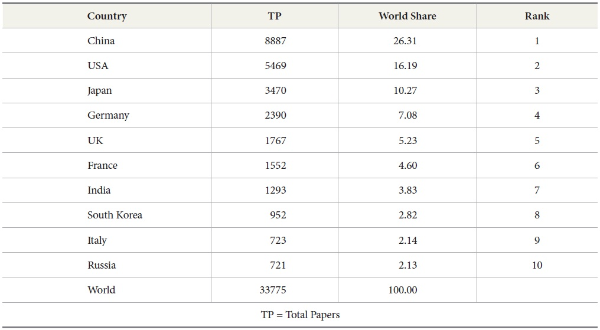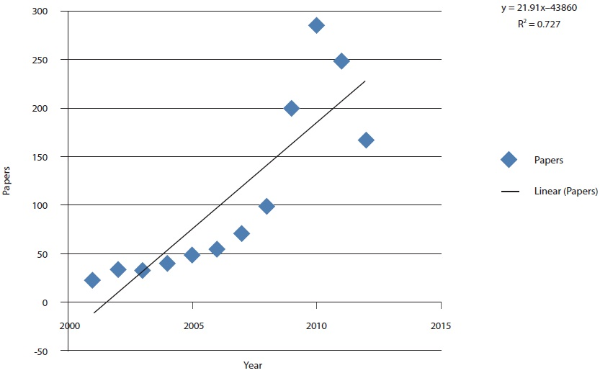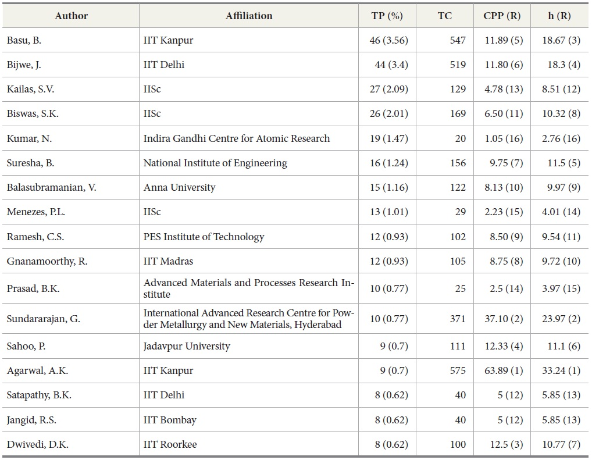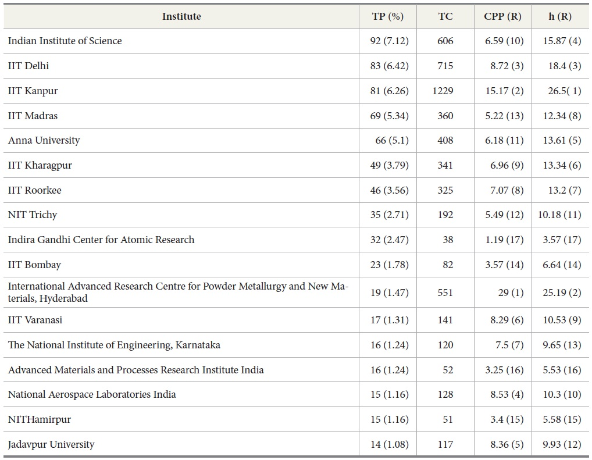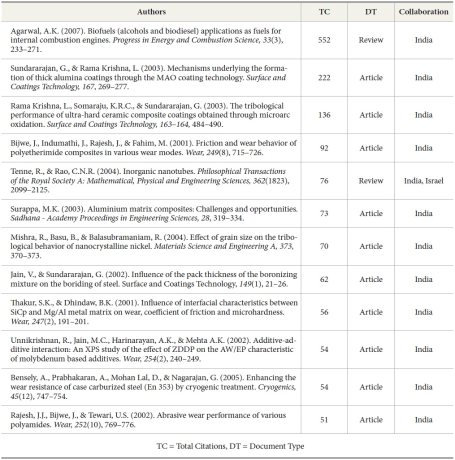ISSN : 2287-9099
Publication Trends and Citation Impact of Tribology Research in India: A Scientometric Study

B. Elango (IFET College of Engineering)

J. Manickaraj (SRM University)

Abstract
This paper analyzes India’s contribution to world tribology research during the period 2001–2012 based on SCOPUS records. India’s global publication share, annual output, and its citation impact of Indian contribution, partner countries, leading contributors, leading institutes, and highly cited papers were analyzed. Additionally, a cloud technique is used to map frequently used single words in titles. It is observed that India ranks in the 7th position with a global publication share of 3.83% and an annual average growth rate of 25.58% during the period 2001–2012. The citation impact of India’s contribution is 6.05 which decreased from 12.74 during 2001–2006 to 4.62 during 2007-2012. 17.4% of India’s total research output was published with international collaboration.
- keywords
- Tribology Research, Scientometrics, Word Cloud, India
1. INTRODUCTION
Tribology is the science and technology of two interacting surfaces in relative motion and of related subjects and practices. The term was coined by Jost (1966) in a report and derives from the Greek word tribos. Tribology is a multidisciplinary field which incorporates a number of disciplines, including mechanical engineering, material science, mechanics, surface chemistry, surface physics, and a multitude of subjects such as surface characterization, friction, wear, lubrication, thin films and coatings, materials, lubricants, and the selection and design of lubrication systems and contact properties.1 The application of tribological principles is essential for reliability of motor vehicles, in order to reduce friction and wear with minimum adverse impact on the environment. A study estimated that the cost of friction and wear in India is Rs.78.67 billion, and 50-60% of equipment damage is caused by poor lubrication and severe wear (Singh, Vimal & Chaturvedi, 2012). Mukhopadhyay (2011) estimated that savings up to 20% of gross national product can be achieved by paying proper attention to tribology especially in the areas of education, research, and application. New areas of tribological studies have been developed at the interfaces of various scientific disciplines, like nanotribology, biotribology, and green tribology (Assenova et al., 2013). BHEL was the first industry in India to start a department of tribology for analyzing its journal and bearings failure used in rotating machines. In the education field tribology is not a subject in the curriculum although some attempts have been made by IITs to introduce tribology course at the masters’ level (Biswas, 2007). With this background, the present study is designed to examine the Indian status on tribology research at a global level and to explore the leading Indian contributors (authors and institutes) during the period of 12 years from 2001 to 2012.
2. RELATED STUDIES
Various quantitative studies on different branches of learning analyzing India’s contribution have been carried out in the past. Gupta, Kshitij, and Verma (2011) analyzed the Indian contribution in computer science published during 1999-2008 based on the bibliographic records retrieved from SCOPUS. Kaur and Gupta (2010) studied 1380 Indian dental science papers published during 1999-2008 as covered in SCOPUS. They focused on research output and quality, identification of leading authors and institutions, and major collaborating partners. Varaprasad and Ramesh (2011) analyzed the growth of Indian chemical research published during 1987-2007 based on the SCOPUS records with a focus on quantifying the national contribution and identifying the most productive institutions. Gupta, Kaur, and Kshitig (2011) analyzed the contributions of India in dementia research as reflected in SCOPUS for the period of 10 years from 2002 to 2011. Gupta, Kaur, and Bala (2011) mapped the Indian diabetes research output published during 1999-2008. They focused on pattern of international collaboration and characteristics of highly cited papers. Kademani, Sagar, and Bhanumurthy (2011) conducted a quantitative assessment on materials science publications in India for a period of 10 years from 1999-2008 based on the SCOPUS database. They studied growth of publications, national and international collaboration, highly productive institutions and authors, and highly cited publications.
Karpagam et al. (2011) mapped the nanoscience publications contributed by Indian authors for a period of 20 years from 1990 to 2009 based on the SCOPUS database. They measured the growth rate, pattern of author collaboration, and pattern and impact of Indian institutions contributions by various scientometric measures. Rajagopal et al. (2013) analyzed the growth and development of pheromone biology research output in India based on the Science Citation index for the period 1978-2008. Sinha & Joshi (2012) examined the status of solar PV research in India for the 10 year period 2000-2009. Rajendran, Manickaraj, and Elango (2013) analyzed research output in the field of wireless communication contributed by Indian scientists for the period of 12 years from 2001 to 2012. They focused on growth of literature, collaboration of authors, and pattern of research communication. Gupta and Bala (2011) analyzed the research activities of India in medicine during 1999-2008 based on the SCOPUS database. Their focus was on evaluating the research performance of different Indian medical colleges, hospitals, research institutes, universities, and research foundations. However, we did not find any studies which reported on tribology research in the past from the above research literature.
4. METHODOLOGY
A total of 1,293 papers contributed by Indian authors to world tribology research during the period of 12 years from 2001–2012 has been considered for the present analysis. The bibliographic records related to the tribology research have been retrieved and downloaded from the SCOPUS (Elsevier) database. The keyword *tribolog* has been used in the combined fields of Title, Abstract, and Keyword.
Further searches were refined to Indian affiliations where the papers were attributed to at least one Indian author. Only articles, conference papers, and reviews (Elango, Rajendran & Bornmann, 2013) have been considered for the present study. The bibliographic details and citations profile were downloaded on April 25, 2013. A straight count method is applied where the corresponding author of a paper receives the full credit (Moya-Anegón et al., 2013; Tellez & Vadillo, 2010). The h-index (Hirsch, 2005; Schubert & Glänzel, 2007) is applied to evaluate publication output along with traditional bibliometric indicators, such as number of papers, share of international collaborative papers, internationalization index, number of citations received, and citations per paper. Additionally a cloud technique is used to analyze the frequency of single words in titles.
4.1. Word Cloud Visualization
A word cloud is a beautiful informative image that communicates much in a single glance. Tagcrowd specializes in making word clouds easy to read, analyze, and compare for a variety of useful purposes. It was created by David Steinbock and is a handy website that allows anyone to create a tag cloud from a file or pasted text (3 MB of data). To visualize the hot topics in Indian tribology research, the word cloud online tool Tagcrowd was used. The controls allow you to add a numerical frequency display, group similar words, and turn off common word filters. To generate a word cloud, the following steps (Zhang, Huang, & Li, 2011) are followed:
-
All of the titles from the research output are extracted and entered into an online word cloud generator, Tagcrowd ( http://www.tagcrowd.com).
-
Set the maximum number of words and exclusion criteria.
-
Visualize.
5. RESULTS
5.1. Share of Top Ten Countries
The global publication share of the top ten countries in tribology research varies from 2.13% to 26.31% during the period 2001–2012 (Table 1). The top ten countries together produced 68% of world tribology research output. China tops the list with a share of 26.31% followed by the USA with 16.19% and Japan with 10.27%. These top three countries together produced 53% of world publications. India ranked seventh among the top ten most productive countries with a global publication share of 3.83%.
5.2. Indian Publication Output and its Citation Impact
India contributed 1,293 papers to world tribology research during the period 2001–2012 with an average number of papers per year of 108 (Table 2). Cumulative publications have increased from 227 in 2001–2006 to 1066 in 2007–2012 with a growth rate of 369%. A total of 7,817 citations have been received by these papers from its time of publication up to April 15, 2013. Of 1,293 papers, 863 papers received one or more citations (ranging from 1 to 552) from their publication. Citations per paper were 6.05 during the study period, which has decreased from 12.74 in 2001–2006 to 4.62 in 2007–2012.
The annual number of papers in tribology research contributed by Indian scientists increased from 21 in 2001 to 166 in 2012 with a peak of 285 in 2010. The coefficient of determination of number of publications is found to be R2 = 0.7276 which indicates that the literature was expanding at a considerable growth rate (Fig. 1). The linear best fit was found to be y = 21.913x–43860 where y is number of papers and x is the predicting year. With this, the predicted number of papers is 339 for the year 2017 which is twice that in 2012.
5.3. International Collaborative Papers
India published 17.40% of its total papers with international collaboration during the period 2001–2012 which has increased from 12.33% in 2001–2006 to 18.48% in 2007–2012 (Table 3).
Major international partner countries are listed in Table 4 and India collaborated with 34 countries during the study period. There were 256 international links in the 225 international collaborative papers, and the internationalization index is 19.80 (=100 x number of international links / total number of papers by India) (Frame & Carpenter, 1979) for tribology research contributed by Indian researchers / scientists. Among the partner countries, the USA had most of the links with 81. Five G7 countries are listed among major partner countries which indicate that India has more frequent partnerships with scientists from G7 countries.
5.4. No. of Countries by Line and Citation Impact
India published papers with a maximum of three countries during the period 2001–2012 (Table 5). Citation impact of papers with three or more countries received the highest score with 8.33 followed by national output with 6.35. Papers with three countries registered a lowest citation impact of 3.04.
5.5. Prolific Indian Authors in Tribology Research (2001–2012)
Authors contributing more than 0.5% of the country’s output during 2001–2012 are considered prolific authors and listed in Table 6. Among the 17 most productive authors, 7 authors are from IIT’s and 3 from IISc. B. Basu of IIT Kanpur was the most productive author with 46 papers (3.56%) followed by J. Bijwe of IIT Delhi and S.V. Kailas of IISc. A.K. Agarwal of IIT Kanpur had the highest CPP of 63.89 followed by G. Sundararajan of IARCPMNM Hyderabad (37.1) and D.K. Dwivedi of IIT Roorkee (12.5). The prolific authors had h-index in range from 3.97 to 33.24. The author A.K. Agarwal had the highest h-index value of 33.24 while B.K. Prasad had the lowest at 3.97.
5.6. Prolific Indian Institutes in Tribology Research (2001–2012)
Institutes contributing more than 1% of the country’s output during 2001–2012 are considered prolific institutes and listed in Table 7. These 17 prolific institutes contributed 688 publications (53%) of the country’s output with a range of 14 and 93 papers. Papers contributed by these prolific institutes received 5,437 citations (~ 70%) from their time of publication of a total 7,817 citations. The top five institutes for production (IISc, IIT Delhi, IIT Kanpur, IIT Madras, and Anna University) contributed 391 papers accounting for 30% of the country’s output. The CPP of these prolific institutes varies from 1.19 to 29. Among the prolific institutes, the International Advanced Research Centre for Powder Metallurgy and New Materials, Hyderabad received the highest CPP of 29 followed by IIT Kanpur (15.17) and IIT Delhi (8.72). Only two universities, namely Anna University and Jadavpur University, are listed among the prolific institutes. Four research institutes are listed among the prolific institutes. IITs and IISc together published 461 (36% of the country’s output) papers related to tribology during 2001–2012 and this suggests that these are the specialized Indian institutes in tribology research. The highest h-index was achieved by IIT Kanpur, followed by International Advanced Research Centre for Powder Metallurgy and New Materials, Hyderabad (h-index = 25.19) and IIT Delhi (h-index = 18.4), while the lowest is by the Indira Gandhi Center for Atomic Research (h-index = 3.57) among the prolific institutes.
5.7. Most Preferred Journals
The most productive journals published at least 10 papers contributed by Indian authors are listed in Table 8. These top 22 journals together produced 600 papers contributed by Indian authors comprising 46% of the total Indian output. Only 2 journals originated from India (Sadhana and Transactions of the Indian Institute of Metals) and the remaining journals originated from different countries. It indicates that Indian authors prefer to publish their research findings in international journals more than in Indian ones. Wear ranked top with 121 papers in terms of number of papers while this journal ranked third in terms of CPP. Surface and Coatings Technology received the highest CPP with 17.1 while it is ranked fourth in terms of number of papers. Sadhana ranked fifth in terms of CPP while it is ranked 14th in terms of number of papers.
5.8. Highly Cited Papers
Characteristics of highly cited papers (having >50 citations) of Indian tribology research during the period 2001–2012 are presented in Table 9. 12 papers received 50 or more citations and these 12 papers have been published in 7 different journals. Of these 7 journals, one journal originates from India while others are from international locations. Out of 12 papers, two were contributed by a single author while others have collaborators. Cumulative citations of these 12 papers are 1,498 accounting for 19% of all citations. One paper has been published with international collaboration (Israel) while others have domestic collaboration (India). The top-cited paper is “Biofuels applications as fuels for internal combustion engines,” authored by A.K. Agarwal for Progress in Energy and Combustion Science in the year 2007 which was published as Review Paper. This paper has received 552 citations from its time of publication through April 25, 2013.
5.9. Analysis of Words in Title
Article titles contain information about the whole paper which can express the authors’ attitude to the readers, and analysis of words in title gives the exact trend of particular research fields (Malarvizhi, Wang, & Ho, 2010; Sun, Wang, & Ho, 2012; Ma, Ho, & Fu, 2011). Fig. 2 provides information about the frequency of single word in titles of research papers contributed by Indian tribologists. Some prepositions such as of, and, the, and or are discarded from the display. Common words like during, analysis, study, performance, investigation, behavior, experiment, tool, characteristics, properties, evaluation, conditions and based were omitted from the analysis. The font size of the text indicates how often the word is used. It can be observed that Composites and Friction are high frequency words followed by Tribology and Wear.
6. DISCUSSION AND CONCLUSION
This paper analyzed the growth of tribology research output, international collaborative share, partner countries, citation profile, and prolific authors and institutes, and identified highly cited papers in India’s contribution to world tribology research output during 2001–2012. Indian scientists published 1,293 papers during the period 2001–2012 with a global publication share of 3.83% and with 225 (17.40%) papers produced by international collaborations. Compared to the research fields of dementia (Gupta, Kaur, & Kshitij, 2011) and pheromone biology (Rajagopal et al., 2013), the publication output in this field is in a better position. Indian literature in tribology has grown by 369% between 2001-2006 and 2007-2012, which shows that there is an increasing trend of research activities in tribology research. India was 7th among the top ten most productive countries of the world in tribology research during 2001–2012. Compared to South Korea, Italy, and Russia, the world share of India’s publication output is in a better position. However, India produced a small quantity of publications in comparison to China, the USA, and Japan, which produced 10% or more of world publications. 17.4% of the country’s papers were contributed with international collaboration and the USA was the most preferred partner. The share of international collaborative papers in India’s contribution is greater than for materials science (14.75%) (Kademani, Sagar, & Bhanumurthy, 2011) and medicine (11.87%) (Gupta & Bala, 2011). The internationalization index is 19.8 for Indian tribology research, which is greater than for neuroscience research in India (Shahabuddin, 2013) where it was 16.14. 67% of the country’s output received citations in a range between 1 and 552. The citation rate of Indian contribution was 6 which is better than computer science (1.13) (Gupta, Kshitij, & Verma, 2011) and dental science (1.38) (Kaur & Gupta, 2010). Almost 67% of papers received one or more citations (ranges: 1–552) since their time of publication. Prolific institutes produced 53% of the country’s output which indicates that the number of institutes engaged in tribology research was limited. Prolific authors produced 22.5% of the country’s output which indicates that Indian tribology research is diffused with many authors. Analysis of single words in titles shows that composites, friction, tribology, and wear are frequently used words by Indian tribologists. The present study concludes that the Indian contribution to world tribology research has increased greatly in the last six years (369%). However, it is noted that world tribology research is presently led by China, the USA, and Japan based on the number of publications.
- Submission Date
- 2013-12-17
- Revised Date
- Accepted Date
- 2014-03-14


